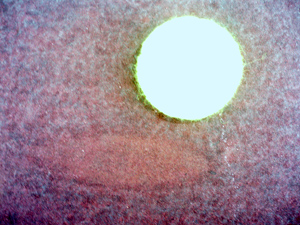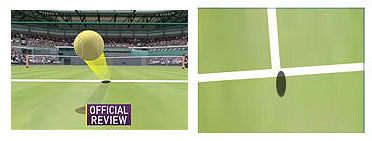Computers and Tennis
by Andrew Boyd
Today, where did that ball bounce? The University of Houston's College of Engineering presents this series about the machines that make our civilization run, and the people whose ingenuity created them.
"Kill the umpire!" "You're blind, ref!" Challenging officials seems as much a part of sports as playing the game. It's easy to understand why. We want competitors to win or lose because of how they play, not because an official made a mistake.
And that's why we've turned to technology for help. In some sports — like football — our efforts are pretty basic. We let referees review plays on videotape. But in other sports the technology is quite sophisticated. Take tennis.
The rules of tennis aren't open to a lot of interpretation. A player's shot is good if it lands in the court. Calling a ball in or out seems a simple enough job for officials. But anyone who's watched tennis knows it's not that easy.
For one thing, tennis balls move fast. Good men's tennis players hit serves over 120 miles an hour. That means the ball travels the length of two cars in the time it takes to blink. An official who blinks at the wrong time has missed the action.
But there's also the problem of what it means to bounce. If you look at a tennis ball's bounce mark, it's not a circle. It's an oval. That's because the ball's moving forward while it's compressing and releasing. The length of the oval bounce mark can be many times the diameter of the ball. It depends on the court surface. Grass courts like Wimbledon are slippery and have long bounces. Clay courts, like those used in the French Open, have shorter bounces. You can actually see the shape of a bounce if you play on a clay court. The U.S. and Australian Opens are played on hard courts — courts made from a substance like concrete. The length of the bounce depends on how smooth the surface is. No matter what the surface, a line umpire must determine if any part of the bounce is inside the court.

A tennis ball bounce mark. The oval mark can be seen below and to the left of the tennis ball.
Cyclops was one of the first technologies adopted by professional tennis. Introduced in the late seventies, it uses beams of light to tell when a serve is good.
The latest and greatest technology is Hawk-Eye. Hawk-Eye watches the ball with a collection of high speed cameras. But that's only where the magic begins. Even high speed pictures don't see the ball at every instant of time. Hawk-Eye uses computer algorithms and mathematical abstraction to fill in the blanks. Where was the ball at each moment? How did it deform when it bounced? Hawk-Eye ultimately creates a picture of the ball's bounce superimposed on a picture of the tennis court. From there it's easy to see if the ball's in or out.

Hawk-Eye isn't perfect. But it's proven to be much more accurate than the human eye. That's a result of good engineering. And it's really no surprise. Calling a ball in or out is a mechanical task, like adding a long column of numbers. Computer systems are good at that. But they may take some of the fun out of the game. "Kill the computer" just doesn't have the right ring to it; at least, not in a sports arena.
I'm Andy Boyd at the University of Houston, where we're interested in the way inventive minds work.
Notes:
Hawk-Eye is a product of Hawk-Eye Innovations.
Photo of tennis ball and bounce mark by E. A. Boyd. Computer generated pictures are taken from the web site of Hawk-Eye Innovations.